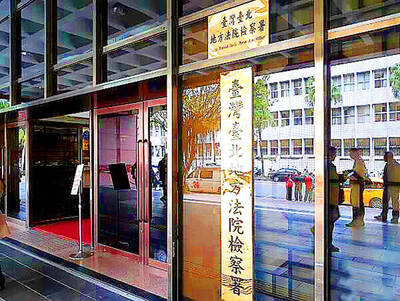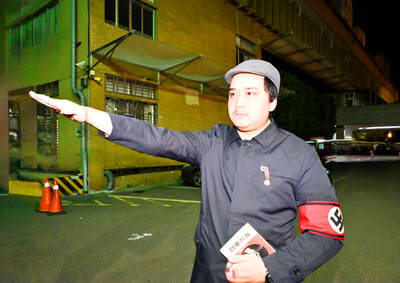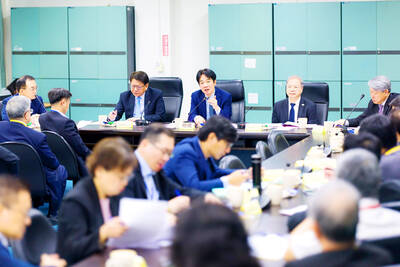Deputy Minister of National Defense Andrew Yang (楊念祖) told a Washington symposium on Tuesday that although President Ma Ying-jeou’s (馬英九) administration was doing everything in its power to maintain peace, it still considered China a “major threat.”
“We are fully aware that we are facing a clear and present threat from the other side of the Taiwan Strait,” he said.
Yang, on a short private visit to the US, said he had not spoken with US officials about the possible sale of F-16C/D fighter planes and that he had received no updated information.
A response to Taiwan’s request to buy 66 of the planes is expected before the end of this year.
There was little more that Taiwan could do to persuade the US to sell the fighters, he said, adding: “It is up to the US to make a decision, or not.”
Yang was speaking at a symposium organized by the Washington-based “Project 2049 Institute” to release a new report titled Evolving Aerospace Trends in the Asia-Pacific Region — Implications for Stability in the Taiwan Strait.
He said that Chinese missiles arrayed against Taiwan sent a “very negative message” because they represented an intention to use non-peaceful means to reach Beijing’s goals.
A Chinese assault, he said, could begin with a “massive missile attack” attempting to neutralize Taiwan’s defense infrastructure and major political centers.
The country, he said, had to “try its best” to survive such an attack and demonstrate that it could “stand up against the aggressors.”
He said that he hoped Beijing would realize that the use of force would not succeed and that even if it did, it would result in a regional disaster.
Asked about the crisis caused by the sinking of a South Korean warship by a North Korean submarine, Yang said the incident showed friction could have a great impact on regional security and stability. He said he hoped Beijing would also learn from what had happened and avoid miscalculation.
The report said that the potential for a Chinese military attack on Taiwan remained the “primary flash point” in the Asia-Pacific region.
“It is also the contingency that most likely would bring the US and China, as well as others in the region, into armed conflict,” the report said.
Written by Mark Stokes, a US expert on Taiwan’s military affairs and executive director of the “Project 2049 Institute,” the report said a “relative erosion” of Taiwan’s military capabilities could create opportunities and incentives for Beijing’s political and military leadership to take greater risks in cross-strait relations, “including resorting to force to resolve political differences.”
In order to deter perceived moves toward de jure independence, China sought the capacity to dominate the skies over Taiwan, the report said.
The Taiwan independence “threat” also conveniently justified the People’s Liberation Army’s (PLA) budget increases at a time when money was tight, the report added.
“It also allows for an accelerated pace of modernization without excessive alarm from others in the region. The focus on Taiwan is useful in developing capabilities applicable to other contingencies around China’s periphery,” the report said.
It recommended the US adopt a mixture of positive and negative incentives to persuade civilian leaders in Beijing to increase their commitment to peaceful means to resolve political differences with Taipei and to reduce the missile deployment opposite Taiwan.
Because anti-missile systems and other defenses were insufficient to undercut “the coercive and military utility” of China’s ballistic missiles and land attack cruise missiles (LACM), the report said that Taiwan’s reported program to field the Hsiungfeng-2E indigenous LACM was “not without reason.”
In 2005, media reports alleged that at least 24 launchers had been manufactured, along with an unknown number of missiles that could cover more than 20 targets in southeast China. More recently, media reports highlighted further testing of the HF-2E, with plans to produce at least 80 HF-2E LACMs with a range of more than 500km by the end of this year.
“A second track could be to begin assessing options for a multi-role fighter able to operate from shorter runways. A variety of options are worth considering, including the eventual release of the F-35B, the transfer of an existing Vertical and/or Short Take-Off and Landing (VSTOL) design, such as the AV-8B, or the initiation of design work on a VSTOL-capable advanced indigenous defense fighter,” the report said.
Many US experts believe Taiwan should buy or develop a VSTOL fighter because China will try to destroy runways early in a conflict.
A third track, the report said, would be the “principled release” of additional F-16s to Taiwan as an interim bridge to the fielding of a VSTOL airframe.
“Release of additional F-16s would be an appropriate and measured response to the PRC’s growing reliance on ballistic missiles as an instrument of coercion,” the report said. “Should Beijing demonstrate clear intent to redeploy or draw down its five confirmed short range ballistic missile (SRBM) brigades opposite Taiwan, then formal notification to Congress could be deferred. Such an approach constitutes a form of reciprocal unilateralism. However, explicit negotiations linking PRC ballistic missile deployments with US arms sales to Taiwan would be neither appropriate nor desirable.”

INVESTIGATION: The case is the latest instance of a DPP figure being implicated in an espionage network accused of allegedly leaking information to Chinese intelligence Democratic Progressive Party (DPP) member Ho Jen-chieh (何仁傑) was detained and held incommunicado yesterday on suspicion of spying for China during his tenure as assistant to then-minister of foreign affairs Joseph Wu (吳釗燮). The Taipei District Prosecutors’ Office said Ho was implicated during its investigation into alleged spying activities by former Presidential Office consultant Wu Shang-yu (吳尚雨). Prosecutors said there is reason to believe Ho breached the National Security Act (國家安全法) by leaking classified Ministry of Foreign Affairs information to Chinese intelligence. Following interrogation, prosecutors petitioned the Taipei District Court to detain Ho, citing concerns over potential collusion or tampering of evidence. The

Seventy percent of middle and elementary schools now conduct English classes entirely in English, the Ministry of Education said, as it encourages schools nationwide to adopt this practice Minister of Education (MOE) Cheng Ying-yao (鄭英耀) is scheduled to present a report on the government’s bilingual education policy to the Legislative Yuan’s Education and Culture Committee today. The report would outline strategies aimed at expanding access to education, reducing regional disparities and improving talent cultivation. Implementation of bilingual education policies has varied across local governments, occasionally drawing public criticism. For example, some schools have required teachers of non-English subjects to pass English proficiency

‘FORM OF PROTEST’: The German Institute Taipei said it was ‘shocked’ to see Nazi symbolism used in connection with political aims as it condemned the incident Sung Chien-liang (宋建樑), who led efforts to recall Democratic Progressive Party (DPP) Legislator Lee Kun-cheng (李坤城), was released on bail of NT$80,000 yesterday amid an outcry over a Nazi armband he wore to questioning the night before. Sung arrived at the New Taipei City District Prosecutors’ Office for questioning in a recall petition forgery case on Tuesday night wearing a red armband bearing a swastika, carrying a copy of Adolf Hitler’s Mein Kampf and giving a Nazi salute. Sung left the building at 1:15am without the armband and apparently covering the book with a coat. This is a serious international scandal and Chinese

NEGOTIATIONS: The US response to the countermeasures and plans Taiwan presented has been positive, including boosting procurement and investment, the president said Taiwan is included in the first group for trade negotiations with the US, President William Lai (賴清德) said yesterday, as he seeks to shield Taiwanese exporters from a 32 percent tariff. In Washington, US Trade Representative Jamieson Greer said in an interview on Fox News on Thursday that he would speak to his Taiwanese and Israeli counterparts yesterday about tariffs after holding a long discussion with the Vietnamese earlier. US President Donald Trump on Wednesday postponed punishing levies on multiple trade partners, including Taiwan, for three months after trillions of US dollars were wiped off global markets. He has maintained a 10 percent